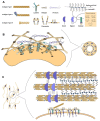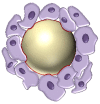Role of Extracellular Matrix in Development and Cancer Progression
- PMID: 30287763
- PMCID: PMC6213383
- DOI: 10.3390/ijms19103028
Role of Extracellular Matrix in Development and Cancer Progression
Abstract
The immense diversity of extracellular matrix (ECM) proteins confers distinct biochemical and biophysical properties that influence cell phenotype. The ECM is highly dynamic as it is constantly deposited, remodelled, and degraded during development until maturity to maintain tissue homeostasis. The ECM's composition and organization are spatiotemporally regulated to control cell behaviour and differentiation, but dysregulation of ECM dynamics leads to the development of diseases such as cancer. The chemical cues presented by the ECM have been appreciated as key drivers for both development and cancer progression. However, the mechanical forces present due to the ECM have been largely ignored but recently recognized to play critical roles in disease progression and malignant cell behaviour. Here, we review the ways in which biophysical forces of the microenvironment influence biochemical regulation and cell phenotype during key stages of human development and cancer progression.
Keywords: cancer progression; extracellular matrix; fibrosis; matrix remodelling; tumour microenvironment.
Conflict of interest statement
The authors declare no conflict of interest.
Figures






Similar articles
-
The matrix environmental and cell mechanical properties regulate cell migration and contribute to the invasive phenotype of cancer cells.Rep Prog Phys. 2019 Jun;82(6):064602. doi: 10.1088/1361-6633/ab1628. Epub 2019 Apr 4. Rep Prog Phys. 2019. PMID: 30947151 Review.
-
The Tumor Microenvironment: Focus on Extracellular Matrix.Adv Exp Med Biol. 2020;1245:1-38. doi: 10.1007/978-3-030-40146-7_1. Adv Exp Med Biol. 2020. PMID: 32266651 Review.
-
Charting the unexplored extracellular matrix in cancer.Int J Exp Pathol. 2018 Apr;99(2):58-76. doi: 10.1111/iep.12269. Epub 2018 Apr 19. Int J Exp Pathol. 2018. PMID: 29671911 Free PMC article. Review.
-
Esophageal Cancer Development: Crucial Clues Arising from the Extracellular Matrix.Cells. 2020 Feb 17;9(2):455. doi: 10.3390/cells9020455. Cells. 2020. PMID: 32079295 Free PMC article. Review.
-
Modeling Physical Forces Experienced by Cancer and Stromal Cells Within Different Organ-Specific Tumor Tissue.IEEE J Transl Eng Health Med. 2024 Apr 15;12:413-434. doi: 10.1109/JTEHM.2024.3388561. eCollection 2024. IEEE J Transl Eng Health Med. 2024. PMID: 38765886 Free PMC article.
Cited by
-
Patient-derived cancer models: Valuable platforms for anticancer drug testing.Front Oncol. 2022 Aug 12;12:976065. doi: 10.3389/fonc.2022.976065. eCollection 2022. Front Oncol. 2022. PMID: 36033445 Free PMC article. Review.
-
Bortezomib induces methylation changes in neuroblastoma cells that appear to play a significant role in resistance development to this compound.Sci Rep. 2021 May 10;11(1):9846. doi: 10.1038/s41598-021-89128-0. Sci Rep. 2021. PMID: 33972578 Free PMC article.
-
A four-gene signature associated with clinical features can better predict prognosis in prostate cancer.Cancer Med. 2020 Nov;9(21):8202-8215. doi: 10.1002/cam4.3453. Epub 2020 Sep 13. Cancer Med. 2020. PMID: 32924329 Free PMC article.
-
Prolyl-4-Hydroxylase α Subunit 2 as a Novel Potential Biomarker for Predicting the Prognosis of Epithelial Ovarian Carcinoma.Cancer Manag Res. 2021 Jun 3;13:4455-4462. doi: 10.2147/CMAR.S302423. eCollection 2021. Cancer Manag Res. 2021. PMID: 34113171 Free PMC article.
-
Characterization of the Prognostic m6A-Related lncRNA Signature in Gastric Cancer.Front Oncol. 2021 Apr 13;11:630260. doi: 10.3389/fonc.2021.630260. eCollection 2021. Front Oncol. 2021. PMID: 33928026 Free PMC article.
References
Publication types
MeSH terms
Grants and funding
LinkOut - more resources
Full Text Sources
Other Literature Sources

